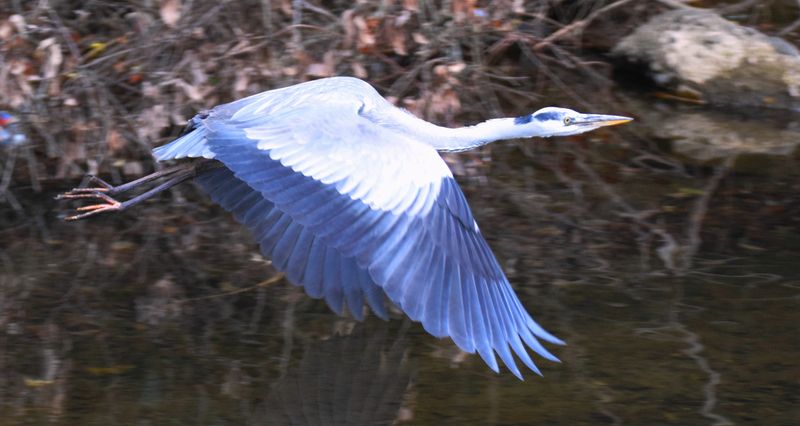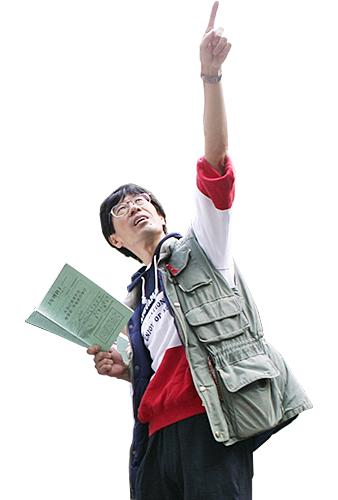理科教諭なべやんの「学内探訪」 Nabeyan's Column
2016年5月より、本校理科教諭の田邉利幸が綴った「学内探訪」コラムを連載していきます。
キャンパス内の名所や豊かな自然環境をご紹介していきます。
連載!理科教諭なべやんの「学内探訪」
<掲載に際して>
「学校」という空間は、人間が生活する環境の中でも”特異”な空間です。本校の場合主に近畿圏各地の居住地域から、900名近い人々がこの岩倉の地に通い、集い、学び、お互いを高め成長する場となっています。
そして午前8時から午後5時までの校内は、未来の無限の可能性を秘めた若者の活気が満ち満ちています。ある場面では授業としての「教科の学び」が、また「かけがえのない友人との語り合いや交流」が、そして放課後は「個性的で多様な先輩や後輩との学び合い」と、学び通しの9時間があっという間に過ぎていきます。
これらのさまざまな経験は、今後の豊かな人生を築き上げていく上で何よりも大切な宝物です。
そんな豊かな3年間を「学校環境」の視点から振り返ってみた時、この地には四季折々に変化する比叡山や北山、西に流れる岩倉川の自然の景観や、季節の移ろいを感じて多様に変遷する豊かな動植物が生息しています。そして同時に、香山建築研究所の設計による建造物、空間構成、そこに組み込まれた”芸術作品”にも注目したいと感じました。子どもたちが快適に生活できることを何よりも大切にし、校地の空間や構造物のデザイン、校舎間や空き地への動きを科学する「動線の科学」、教科教室内の機能性や教科MSの空間構成など、本校に関わるデザイン的要素のすべてが「芸術作品」であり、また、「建築工学の最先端の現場」でもあるように思うのです。いわば子どもたちは、宇宙・自然・芸術・環境・人間・工学の多様な視点から創造された作品群の中で学校生活を送っていると言っても過言ではないと思います。
ある時、何気なく校内を歩いていると、自然物や構造物の方から次から次にメッセ-ジが伝わってきました。今回そのメッセ-ジに促されて、「学内探訪」(適宜「学外探訪」も)と題する連載を記してみます。雑駁な文章で不足を感じる点は多々ありますが、ご一読いただきご批判、ご鞭撻いただければ幸いです。尚、英文Summaryは本校英語科のDavid Foremanが担当しています。
田邉利幸
第83回 <学外探訪10>ヌ-トリアの祈り
~外来生物の悲哀~

「人新世」(Anthropocene)という時代が始まっています。正式な地質学用語ではありませんが、ヒトが地球の自然に与えている負荷の大きさから名づけられています。
人類の産業革命以後の約200年もの間の、大気汚染、森林伐採、そして地球温暖化などの環境破壊の影響は余りにも大きく、「完新世」(Holocene)という時代からすでに移行しているというのです。
このことは近年の気象災害でも実感しますが、生物の世界でも人類の影響で攪乱が進んでいます。
新型コロナウイルスの感染爆発も、ヒトの節度のない行動が原因だとする意見もあります。
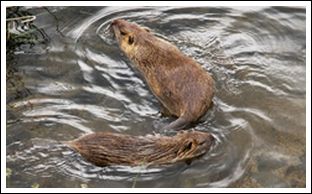 写真の可愛らしい動物は鴨川出町柳付近で繁殖している「特定外来生物」です。このヌ-トリアという動物は、南アメリカ原産のネズミ目(齧歯目)の動物で、本来現地で幸せに暮らしていました。しかし戦時下の兵隊の毛皮に有益として無理やり輸入され、需要がなくなると放置、当然野生化して数が増え「害獣」と指定されました。人類の身勝手な行動のひとつです。
写真の可愛らしい動物は鴨川出町柳付近で繁殖している「特定外来生物」です。このヌ-トリアという動物は、南アメリカ原産のネズミ目(齧歯目)の動物で、本来現地で幸せに暮らしていました。しかし戦時下の兵隊の毛皮に有益として無理やり輸入され、需要がなくなると放置、当然野生化して数が増え「害獣」と指定されました。人類の身勝手な行動のひとつです。
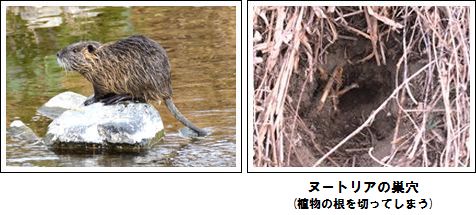
ある時、滝の前で手を合わせて祈る1匹のヌ-トリアに出会いました。私には「早く故郷の南アメリカに帰らせて」との声が聞こえました。
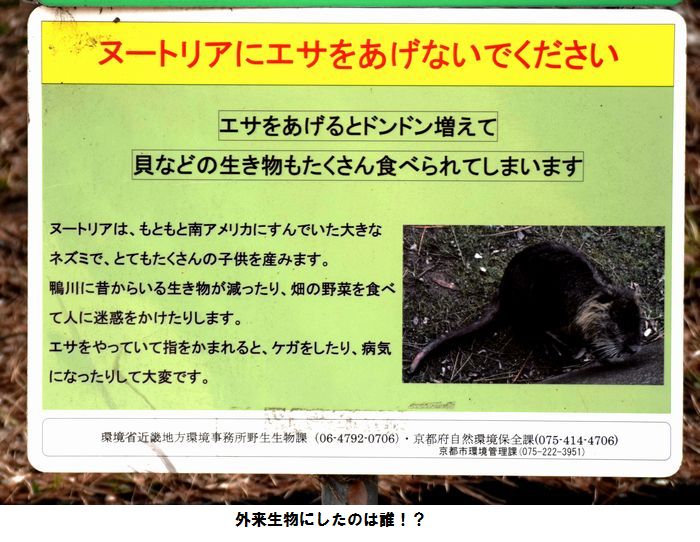 The “Anthropocene” period has begun. While this is not an official name, it comes from the fact that humans are putting great pressure on nature now.
The “Anthropocene” period has begun. While this is not an official name, it comes from the fact that humans are putting great pressure on nature now.
For about 200 years, since the start of the industrial revolution, humans have polluted the air, cut down forests, and contributed to environmental disasters such as global warming, meaning that we have moved on from the “Holocene” period.
We have been able to see many meteorological disasters in recent years, and have seen the effects of it on the nature around us. It could be said that Covid-19 was caused by humans’ uncontrolled behavior.
The cute animal that you can see in the photo is an “introduced species” that lives around the Kamogawa-Demachiyanagi area. This animal is called a Nutria and it is a rodent from South America, where it used to live happily. They were brought to Japan because of their fur, but let loose when they were no longer needed, so they became wild animals and reproduced at a fast rate and have been classed as “vermin”. This is another example of a selfish act by humans.
One day, I saw a Nutria in front of a waterfall that looked like it was praying with its hands together. To me, it seemed to be saying “Please let me go back to my home in South America.”
第82回 寒い朝の水の作品
~理科野外MSより~
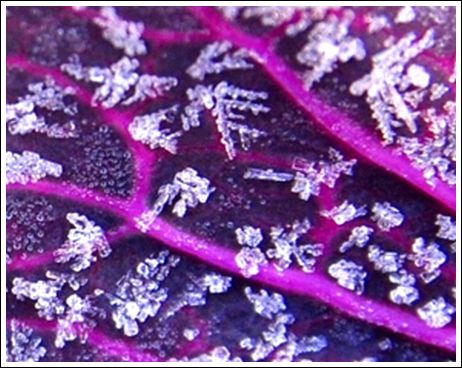
手がしびれるほどに冷えたある日の朝、理科野外MSで生育している葉のキャンバスでは、自然の見事な芸術作品を鑑賞することができました。
「水」(H₂O)という物質は、私たちの体重の6~7割を占め、身の回りでも普通に観察できるありふれた物質です。でも、その水が自ら表現する形状は神秘的です。「雪は天から送られた手紙」(中谷宇吉郎)で有名な”雪の結晶”の形も実に多彩で美しいものです。
“固体が液体に浮かぶ”という特徴も極めて稀で、ほとんどの物質の固体は液体中では沈みます。そんな物質で私たちは生かされています。
 さて、写真上は「霜の結晶」と呼ばれるものです。樹枝状のものや角ばったものなど1枚の葉の上でも多彩です。他にも針状のものが葉の輪郭や全面を覆ったり、一度溶けた霜が再度氷結した(?)雫状のものなど、0度まで冷えた朝の葉の上は、水が微妙な条件で表現する多彩な展覧会場になるのです。
さて、写真上は「霜の結晶」と呼ばれるものです。樹枝状のものや角ばったものなど1枚の葉の上でも多彩です。他にも針状のものが葉の輪郭や全面を覆ったり、一度溶けた霜が再度氷結した(?)雫状のものなど、0度まで冷えた朝の葉の上は、水が微妙な条件で表現する多彩な展覧会場になるのです。
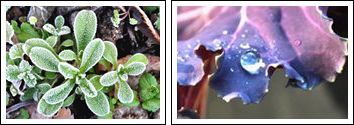
寒い朝は私も苦手ですが、みなさんも少し勇気をもって、自然が創り出す造形物の「無料展覧会場」を訪れてみましょう!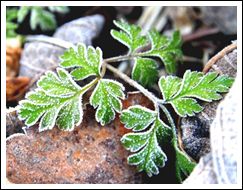
One very cold morning, when I went to check on the cabbages in the Science Department’s outdoor media space, I was able to see a natural work of art.
“Water”(H₂O) makes up 60~70% of our bodies and there is a plentiful supply of it around us. The ways in which water expresses itself is mysterious. Ukichirou Nakaya wrote in the essay “Snow is a Letter from Heaven” about how the shapes of snowflakes are such various and beautiful things.
A solid that has the ability to float on its own liquid is very rare, as most solids sink within liquids, yet we live with such a liquid.
In the photos you can see frost in various shapes and forms on the leaves. Some of them are in needlelike forms, some are droplets of water that have melted once, but then frozen again. These frosts form on the leaves when the temperature falls below 0℃ in the morning, expressing themselves in a variety of ways as if they are part of an exhibition.
I don’t like going out on a cold morning, but let’s be brave and go out to visit this “free exhibitions” produced by nature.
第81回 <学外探訪9>カムチャツカからの使者
~ユリカモメの足環調査~
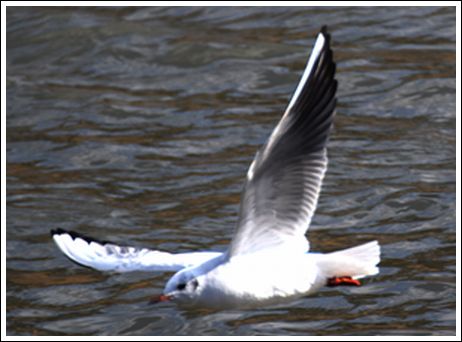
本校には、ツバメ、ツグミなど数多くの渡り鳥が訪れていますが、今回は岩倉川の水が流れる先の鴨川で観られる冬鳥です。
ユリカモメは、繁殖地のカムチャツカ半島から数千キロ離れた京都鴨川まで飛来し、春先まで過ごします。5月頃になると頭部の羽が黒くなり、まさしく英名「Black headed Gull」となってカムチャツカに戻ります。
 京都では1974年に初確認されたユリカモメですが、私は1990年代に野鳥研究家の方とユリカモメを網で捕獲し「足環」を付ける活動に参加したことがあります。
京都では1974年に初確認されたユリカモメですが、私は1990年代に野鳥研究家の方とユリカモメを網で捕獲し「足環」を付ける活動に参加したことがあります。
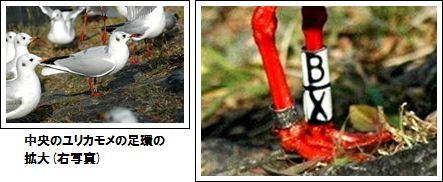
鳥笛でユリカモメを誘い、網で捕獲したあと、布袋に入れて気持ちを落ち着かせ、しばらくしてから体重、翼長などの基本デ-タを測定します。その後、写真のような環境省の金属足環とカラ-リングを取り付けるのです。こうした標識鳥の調査は、当時ロシアのゲラシモフ博士との共同研究で進められました。
私が今でも忘れられない瞬間は、測定のために布袋から取り出した時、首を反転させて測定者の手に激しく噛みついたことです。「野生の力」を眼前で実感したひとときでした。
もし、みなさんが観察している時、「足環」をしたユリカモメがいたら写真を持参してくれたらとても嬉しいです。今年はなぜか丸太町橋より南に集合しています。
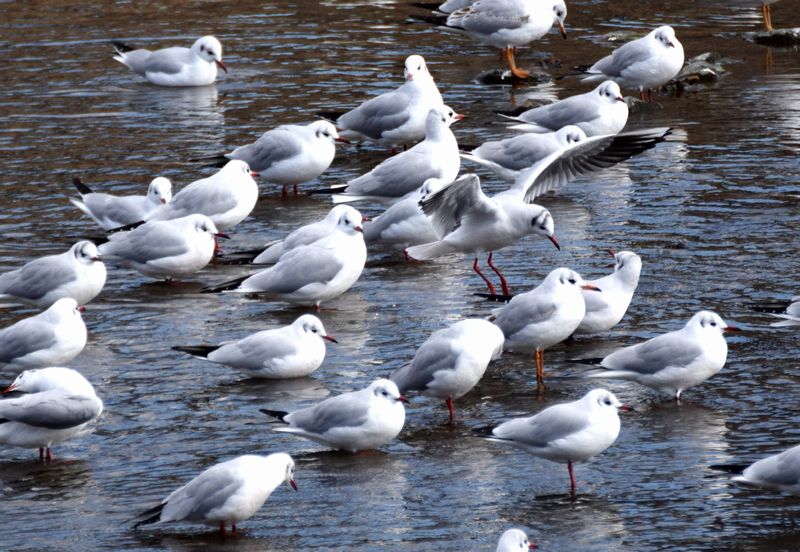
A lot of migrating birds such as Swallows and Thrushes can be seen around our school, but this time I will introduce a bird that can be seen during the winter along the Kamogawa River.
The Black Headed Gulls flies several thousand kilometers to Kyoto from its breeding grounds in Kamchatka Peninsula, where they stay until spring. Around May, the feathers on their heads darken to black and the “Black Headed Gulls” fly back to the Kamchatka Peninsula.
These gulls were first seen in Kyoto in 1974, and I helped bird researchers to capture them in nets and tag them with bands on their legs. We lured them with bird whistles and caught them in nets. We then put them in cloth bags to calm them down for a while before we weighed them and recorded their details. Then we put metal colored bands from the Ministry of Environment on their legs. This was part of a shared research project with Professor Gerasimov in Russia.
I cannot forget the time I took a gull out of the cloth bag and it turned its neck around and bit me. I got to see the power of nature.
If you get a chance to see any of these gulls with tags on their legs, please take a photo for me.
第80回 骨格のある風景
~発展課題「ザ・骨格」より~

3年理科Ⅱの2学期は「生と性と死の学び」というテ-マの学びです。今年度も骨格、脳・神経、感覚、消化、呼吸器などを学び、性については「デ-トDV」、「妊娠、出産」、「LGBTQなどセクシャル・マイノリティ-」などについて深めています。最後は「死の学び」で、各自「人生カレンダ-」を作成します。
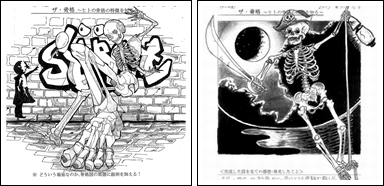 この一連の学びの中に「骨格図作成」の課題があります。進化からみた骨格の特徴を学んだあとの”まとめ”として作成するのです。作成メッセ-ジは「ベサリウスを超えろ!」。ベルギ-の解剖学者で多くの骨格図が有名なベサリウスの上を行くような作品を作成してみようという試みです。
この一連の学びの中に「骨格図作成」の課題があります。進化からみた骨格の特徴を学んだあとの”まとめ”として作成するのです。作成メッセ-ジは「ベサリウスを超えろ!」。ベルギ-の解剖学者で多くの骨格図が有名なベサリウスの上を行くような作品を作成してみようという試みです。
生徒のみなさんは工夫を凝らしながら独特の骨格図を仕上げていきます。右上の作品は樹状細胞、赤血球のそばで何とも楽しそうに踊る骨格図です。このような課題を通じて、これからの社会でより大切な「独創力」「想像力」を磨いてほしいと願っています。

Every year, during the second semester, we study about “Life, Sexuality, and Death” in the Year 3 Science class. This year too, we studied about the human skeleton, the brain and nerves, the senses, digestion, respiration and so on. As for sexuality, we learnt about “Date DV”, pregnancy and birth, and about sexual minorities such as “LGBTQ” and so on. Finally, when looking at death, we each made a “Life Calendar”.
In addition to this, we asked the students to draw a diagram of a skeleton for their homework as a conclusion to their study of evolution. The theme for this was “Outdo Vesalius!”. Vesalius was a Belgian anatomist who was famous for his diagrams of skeletons, so we told the students to try to outdo him.
The students did their best and produced some unique diagrams. As you can see, one picture even had a skeleton dancing with different types of cells from the body. By completing projects like this, we hope that our students can improve their originality and creativity skills for the future.
第79回 <学外探訪8>白きたおやかな舞い
~大鷺町という地名から~
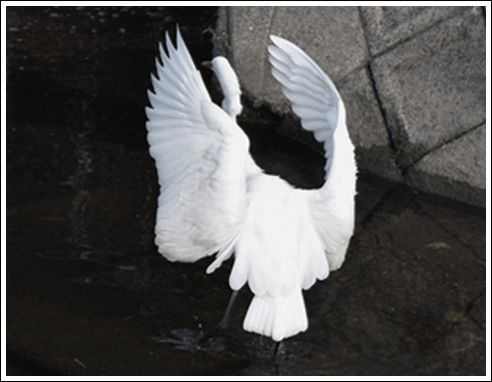
新しい年の始まりに、純白の野鳥の舞いを紹介します。
本校の住所は「左京区大鷺町」です。大鷺町の南東方向には「上高野鷺町」という地名もあり、このあたり一帯は「サギ」の名所であったのではと推測できます。確かに昔の地図をみると、岩倉川は天井川で、その川近くは過去からの河川氾濫などで広汎に湿地帯が広がっていたと考えられます。また本校北東校地にある会館は「しらさぎ」という名を冠した建物です。
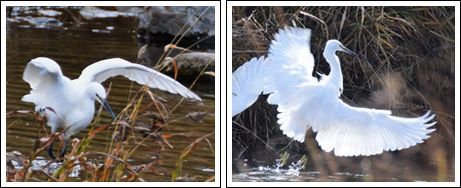 さて、白い「サギ」はよくシラサギと呼ばれますが、「シラサギ」という名の野鳥はいません。全身が白いサギ類の総称なのです。岩倉川ではコサギ、ダイサギ、アオサギが数も多くよく目にします。コサギはその名のとおり小型のサギで、足の先が黄色です。ダイサギとアオサギは別種ですが愛称がよいのか、よく一緒にたたずんでいます。
さて、白い「サギ」はよくシラサギと呼ばれますが、「シラサギ」という名の野鳥はいません。全身が白いサギ類の総称なのです。岩倉川ではコサギ、ダイサギ、アオサギが数も多くよく目にします。コサギはその名のとおり小型のサギで、足の先が黄色です。ダイサギとアオサギは別種ですが愛称がよいのか、よく一緒にたたずんでいます。
不思議とサギは雪の季節に似合います。
寒いからと言って、室内ばかりにこもるのではなく、気分転換に「凛とした寒さを楽しむ」感覚で、身の回りの自然観察を試みてみましょう。もちろん防寒対策は必要です。適度な運動は免疫力(自然免疫)の増強にもつながり、コロナ感染対策としても意味あることだと思います。
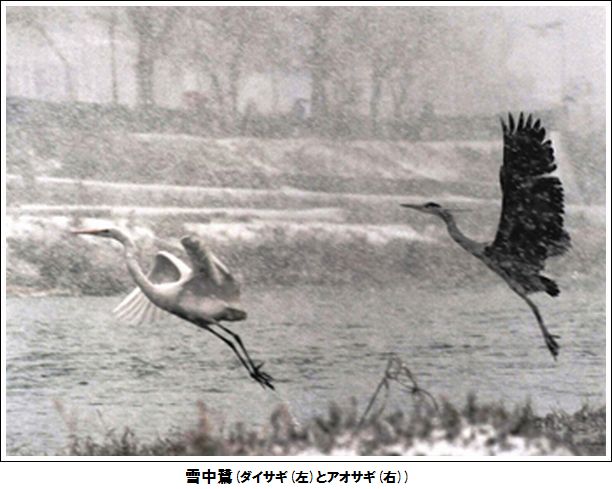
With the start of this new year, we will introduce a dance by a pure white bird.
Our school is located in the Oosagi area of Sakyo-ward. To the south east of this area is the Kami-Takano-Oosaki area, so we could assume that it is because of it being a famous area for herons. We know, by looking at old maps, that there were several swamps that were caused by flooding in the area. Even one of the buildings in our school is named “Shirasagi”.
White herons are often called Shirasagi in Japanese, but there are actually no birds with the name Shirasagi. It’s only because their bodies are white. Along the Iwakura River, we can see Little Egrets, Great Egrets, and Gray Herons. The Little Egret is, as it is named, a smaller bird with yellow on its legs. The Great Egret and Gray Heron are different species, but are often seen hanging around together.
It’s interesting that herons seem to look good in snowy weather. Because it’s cold, we shouldn’t just stay inside, we should get out for a change and feel the fresh cold air, while we feel the nature that is around us. Of course, we should dress up warmly. Exercise is good for building up our natural immunity, so it could be a good countermeasure against the Covid-19 virus.
